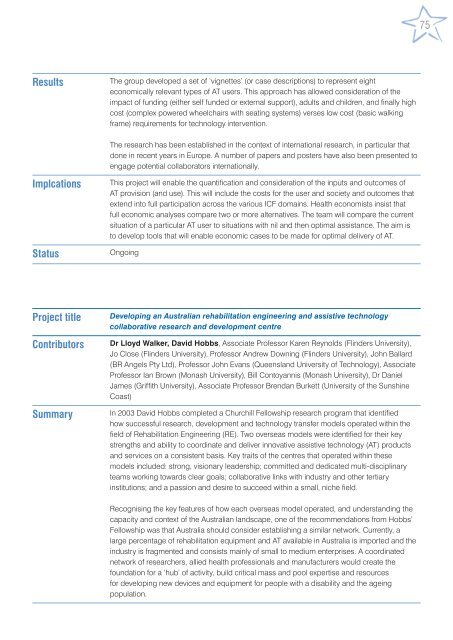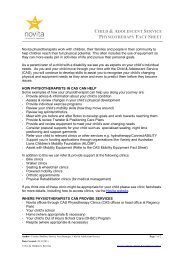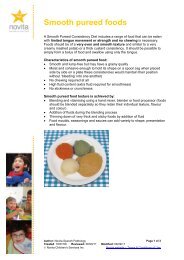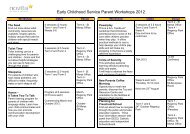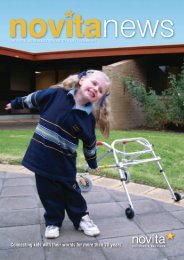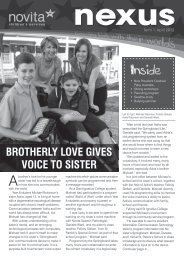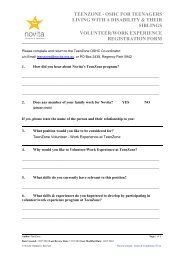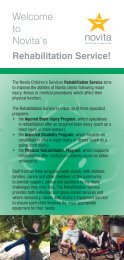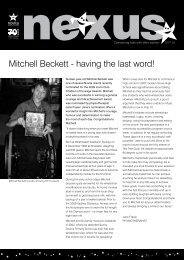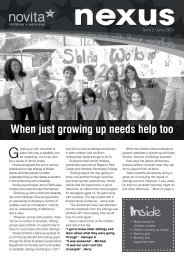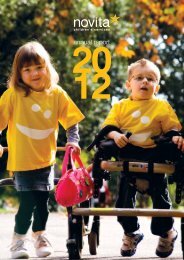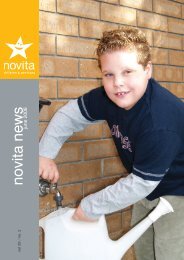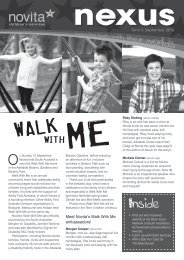Novita Research Report - 2004 to 2007 - Novita Children's Services
Novita Research Report - 2004 to 2007 - Novita Children's Services
Novita Research Report - 2004 to 2007 - Novita Children's Services
- No tags were found...
You also want an ePaper? Increase the reach of your titles
YUMPU automatically turns print PDFs into web optimized ePapers that Google loves.
75ResultsThe group developed a set of ‘vignettes’ (or case descriptions) <strong>to</strong> represent eighteconomically relevant types of AT users. This approach has allowed consideration of theimpact of funding (either self funded or external support), adults and children, and finally highcost (complex powered wheelchairs with seating systems) verses low cost (basic walkingframe) requirements for technology intervention.The research has been established in the context of international research, in particular thatdone in recent years in Europe. A number of papers and posters have also been presented <strong>to</strong>engage potential collabora<strong>to</strong>rs internationally.ImplcationsStatusThis project will enable the quantification and consideration of the inputs and outcomes ofAT provision (and use). This will include the costs for the user and society and outcomes thatextend in<strong>to</strong> full participation across the various ICF domains. Health economists insist thatfull economic analyses compare two or more alternatives. The team will compare the currentsituation of a particular AT user <strong>to</strong> situations with nil and then optimal assistance. The aim is<strong>to</strong> develop <strong>to</strong>ols that will enable economic cases <strong>to</strong> be made for optimal delivery of AT.OngoingProject titleContribu<strong>to</strong>rsSummaryDeveloping an Australian rehabilitation engineering and assistive technologycollaborative research and development centreDr Lloyd Walker, David Hobbs, Associate Professor Karen Reynolds (Flinders University),Jo Close (Flinders University), Professor Andrew Downing (Flinders University), John Ballard(BR Angels Pty Ltd), Professor John Evans (Queensland University of Technology), AssociateProfessor Ian Brown (Monash University), Bill Con<strong>to</strong>yannis (Monash University), Dr DanielJames (Griffith University), Associate Professor Brendan Burkett (University of the SunshineCoast)In 2003 David Hobbs completed a Churchill Fellowship research program that identifiedhow successful research, development and technology transfer models operated within thefield of Rehabilitation Engineering (RE). Two overseas models were identified for their keystrengths and ability <strong>to</strong> coordinate and deliver innovative assistive technology (AT) productsand services on a consistent basis. Key traits of the centres that operated within thesemodels included: strong, visionary leadership; committed and dedicated multi-disciplinaryteams working <strong>to</strong>wards clear goals; collaborative links with industry and other tertiaryinstitutions; and a passion and desire <strong>to</strong> succeed within a small, niche field.Recognising the key features of how each overseas model operated, and understanding thecapacity and context of the Australian landscape, one of the recommendations from Hobbs’Fellowship was that Australia should consider establishing a similar network. Currently, alarge percentage of rehabilitation equipment and AT available in Australia is imported and theindustry is fragmented and consists mainly of small <strong>to</strong> medium enterprises. A coordinatednetwork of researchers, allied health professionals and manufacturers would create thefoundation for a ‘hub’ of activity, build critical mass and pool expertise and resourcesfor developing new devices and equipment for people with a disability and the ageingpopulation.


